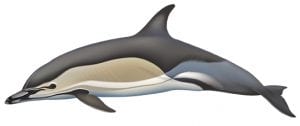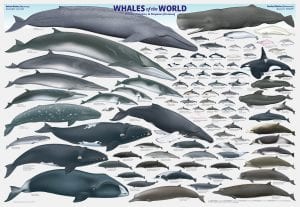Classification & Identification
Whales, dolphins and porpoises are classified as cetaceans. These are aquatic mammals with torpedo-shaped bodies, horizontal tails, multiple stomachs, a layer of blubber, elongated skulls, compressed neck vertebrae, eyes on the sides of their head, and don’t chew their food.
Whales, dolphins and porpoises are classified as cetaceans. These are aquatic mammals with torpedo-shaped bodies, horizontal tails, multiple stomachs, a layer of blubber, elongated skulls, compressed neck vertebrae, eyes on the sides of their head, and don’t chew their food. There are 88 species, 14 of which have baleen (mysticetes) and 74 of which use echolocation and typically have teeth (odontocetes). There is one species (baiji) that has recently been declared extinct, and another (vaquita) very close to extinction. Hundreds more extinct species have been found in fossilized form around the world.

Whales take a variety of shapes. All cetaceans with baleen are called whales; although there are some cetaceans with teeth that are called whales. The largest of all cetaceans with teeth is the sperm whale, they have smaller relatives called pygmy and dwarf sperm whale; there are 22 species of beaked whale, and also the well-known narwhal and beluga.

Dolphins have a beak-shaped snout, curved dorsal fin and sharp, conical teeth. There are 37 species, along with four species of river dolphin.

Porpoises have a smooth, rounded snout, triangular dorsal fin and paddle
shaped teeth. There are seven species.

According to the Integrated Taxonomic Information System
Kingdom: Animalia
Subkingdom: Bilateria
Infrakingdom: Deuterostomia
Phylum: Chordata
Subphylum: Vertebrata
Infraphylum: Gnathostomata
Superclass: Tetrapoda
Class: Mammalia
Subclass: Theria
Infraclass: Eutheria
Order: Cetartiodactyla
Suborder Mysticeti and Odontoceti


